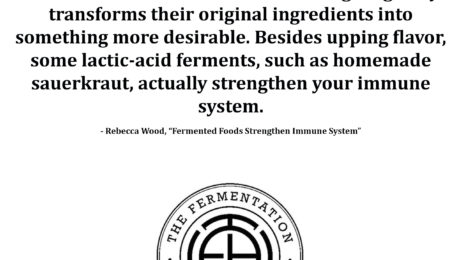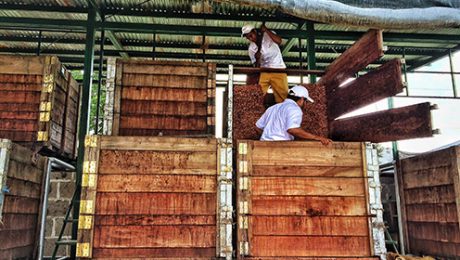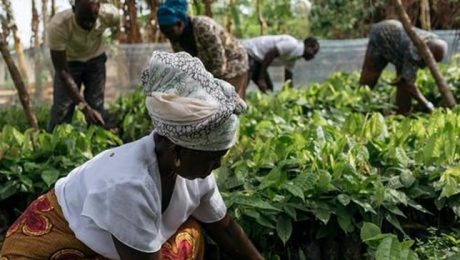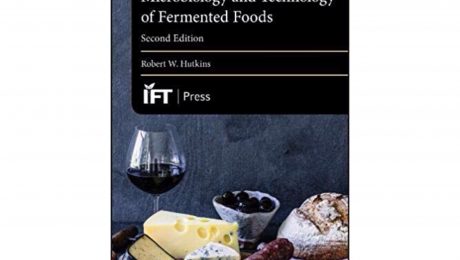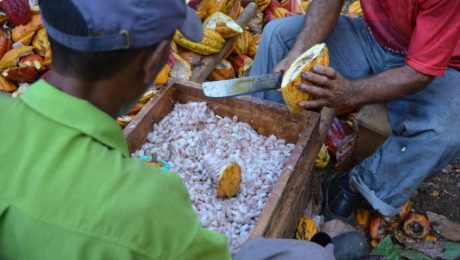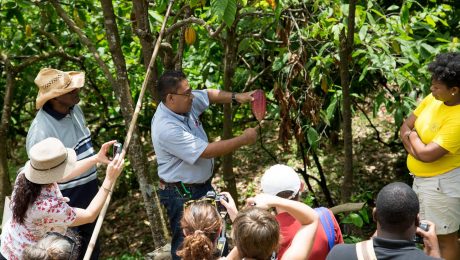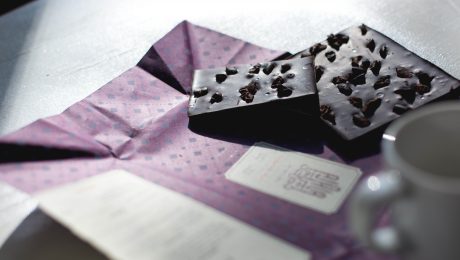Chocolate Sales Skyrocket During Pandemic
Chocolate sales have skyrocketed during the pandemic. Americans spent $3.7 billion on chocolate during the 17-week period that ended June 27,up 6.3% from last year. – Nielsen Data
- Published in Business, Food & Flavor
Rebecca Wood on the Delicious Taste of Fermented Foods
“Why do some foods like chocolate, wine and cheese taste so delicious? Fermenting magically transforms their original ingredients into something more desirable. Besides upping flavor, some lactic-acid ferments, such as homemade sauerkraut, actually strengthen your immune system.”
Rebecca Wood, “Fermented Foods Strengthen Immune System“
- Published in Food & Flavor
Research: Flavor of Chocolate Developed During Fermentation of Cocoa Beans
The specialty chocolate market is growing, and research by the University of Copenhagen Department of Food Science found that fermentation conditions affect chocolate flavor. Different fermentation techniques changes the composition and activity of the microorganisms present on the cocoa beans. “Our research confirms this and we have also learned how to fine tune the cocoa by fine tuning the process itself, which means that you can get a higher quality out of your raw materials if you understand these processes,” says Dennis Sandris Nielsen, a professor in the food science departments at the University of Copenhagen. He adds: “…findings show that the treatment the cocoa receives after the harvest is at least as important for the quality and flavour as the genetics of the cocoa. Where the cocoa was grown also has some significance. By varying the conditions during fermentation, we can therefore also reasonably predict the final taste, which provides good opportunities for high-end producers in particular to develop chocolate with different flavours and scents.”
Read more (University of Copenhagen)
Prices Rise for Cocoa Traders, Manufacturers and Processors
Prices are rising for cocoa traders, manufacturers and processors. This will hopefully benefit cocoa farmers, a difficult, labor-intensive industry. After Ghana and the Ivory Coast threatened to suspend sales of cocoa beans for next year’s season, cocoa buyers are raising the minimum price per metric ton from about $2,124 to $2,600. The governments of the West African countries, where about two-thirds of the world’s cocoa supply is grown, said a higher price is needed to balance what cocoa farmers make and what big commodities traders receive. Cocoa prices have fluctuated greatly in recent years, due to climate change, child labor problems, overproduction and forest destruction. Recently, however, manufacturers are willing to pay more for the cocoa bean because of demand for high-quality chocolate, like dark chocolate, premium variety chocolate and sugar-free chocolate.
Read more (FoodDive)
- Published in Business
Meeting Growing Demands for Fermentation Expertise, Classic Fermentation Textbook Gets New Edition
“To meet the growing demand for fermentation expertise within the food industry,” an updated edition of the textbook “Microbiology and Fermentation of Foods“ has been released by author Dr. Robert Hutkins, a professor at the University of Nebraska-Lincoln and member of the International Scientific Association for Probiotics and Prebiotics. The book was first released in 2006 during a time Hutkins said fermentation was considered an old science, “with nothing new to be learned.” There were few universities offering specific fermentation programs. But recent microbiological advancements — and growing consumer interest in fermented foods — means more people are seeking fermentation expertise. The new edition includes chapters in distilled spirits, cocoa, coffee and cereal products. Hutkins notes scientists across multiple fields are studying fermentation today, from nutritionists to biochemists to archaeobiologists.
Read more (International Scientific Association for Probiotics and Prebiotics)
- Published in Science
Q&A with Katherine Harmon Courage, Author of “Cultured: How Ancient Foods Can Feed Our Microbiome”
When Katherine Harmon Courage began investigating the microbiome 10 years ago as a writer for Scientific American, gut health was barely a blip on the public’s radar. It’s hard to believe today. You can’t walk by a grocery store shelf without reading dozens of labels advertising probiotic health benefits.
Today, gut health is at the forefront of the food industry. The probiotics supplement market is estimated to grow at a CAGR of 9.7 percent in the next seven years. And the market for probiotic-rich fermented foods is expected to grow at a CAGR of 4.98 percent in the next five years.
Gut health research from scientists and dieticians surged in the past decade. Courage was fascinated. “Looking at the food around the world and the connection between our ancient diet and microbes, that is really, really exciting,” she says. Courage spent a year travelling the world, exploring the traditional, gut-friendly cuisine of different cultures. She paired her culinary investigation with modern science into an engaging book: “Cultured: How Ancient Foods Can Feed Our Microbiome.”
Below, highlights from a Q&A with Courage on her new book, and her findings on the fermentation industry’s role in American’s evolving diets.
Q: You have been covering the microbiome since 2009. How has the scientific research progressed?
When I started covering it, there were small studies here and there, a lot from the Human Microbiome Project. Researchers were taking a census at the time, that we share our body with trillions of organisms. It was this niche area that I found super fascinating, but no one was talking about it much.
In the past decade, so much has changed. Science has evolved so much to learn about the connection between our health and our microbiome. We were raised to think germs are bad, bugs are bad, but we live with these commensal organisms.
Q: The food industry is taking notice of this research. What do you think of so many food products marketed with a gut health focus?
Talking to researchers, it’s interesting to see their perspective as scientists. They see the extreme of people thinking probiotics and microbes that are a marketing ploy to other people thinking probiotics and microbes will cure every health issue under the sun.
Microbiologists look at this critically. We’ve seen positive impacts on our health from it, but it won’t solve everything. We’re just at the beginning of understanding this relationship between these amazing and delicious fermented foods and our health.
Q: What’s the biggest misconception about microbes and our microbiome?
One of the misconceptions — and the one I had when I was thinking about this book — was the notion that if we eat something labeled probiotic, like a cup of yogurt, that we’re reinoculating our gut and restoring our gut health. Like if we eat a cup of yogurt, we’re good to go.
These microbes that we eat don’t stick around permanently. They’re just along for the ride. Weeks after we consume these, they’re not there anymore. When I learned this, I thought “There goes my research.” But when I looked into it more, in traditional culture and cuisines, people are eating fermented foods all the time, every day. It’s not about that one special food you eat or that one magic pill. It’s having those foods part of your daily cuisine and part of your life.
It’s great for fermentation producers. You don’t eat one jar of kimchi and call it good — you need to keep integrating it into your diet.
Q: Can a pill really fix our gut health?
Not being a scientist, I can’t say if it will or won’t fix our gut health. But talking to microbiologists who study this, it really is about exposing our bodies to these bacteria. We live our lives in such clean and pasteurized lives that we don’t get that microbial exposure. Their perspective is eating as many bugs, exposing ourselves to as many bugs, it will have a positive impact on our immune system as long as we’re healthy. A lot of the probiotic pills have been studied and they have positive health correlations, but we’re still learning so much about it.
Eating fermented foods, especially wild fermented foods, can be even more beneficial. Microbiologists and researchers in this field are really just starting to see what microbes are beneficial to our health. We can expose our bodies to more microbes through wild fermented foods because they’re so much more complex and have so many more microbes, rather than a yogurt with just three different microbes in it. We’re getting so much exposure through wild fermented foods.
Q: Why is it bad if we don’t properly feed our microbiome?
There’s the old friends hypothesis which is similar to the hygiene hypothesis. Our bodies have evolved to expect microbial exposure. But now our immune systems have gotten on this overactive trajectory, attacking these things they don’t need to.
We need to remember our native gut microbes, to feed them the nutrients they need to thrive. When we don’t feed our native microbes the fiber they need to thrive, they’ll eat the mucus lining in our gut, leading to more inflammation and asthma. We need to eat more microbes and feed the native microbes we do have.
Q: Can our native microbes change if we don’t feed them?
There’s been some interesting research out of Stanford’s Sonnenburg Lab. Mice fed on a diet with less fiber tend to have decreased microbiomes. Over generations, as the mice have pups, they pass that microbiome on to their pups. Generations later, these pups have super impoverished microbiomes. And they can’t come back and have a healthy microbiome by feeding them more fiber.
Q: Fermented foods are making waves in the food industry as the next big superfood. Tell me about fermented food in the book?
For the book, I got tor travel all over and explore these different cultures that have different fermented food traditions. I picked four main food places with quintessential fermented food — Greece to research yogurt, Korea to research kimchi, Japan to research miso and Switzerland to research cheese.
One of the cool discoveries I made travelling to these places was I discovered other aspects of the local diet that nourish the microbiome, other fermented foods and whole foods. These countries have different ways of thinking about eating than we do in America.
Q: What was the most eye-opening aspect of exploring other culture’s cuisine?
There were a couple. One, touring one of the big food markets in Seoul, Korea. Kimchi is their national food, but I was shown all these different fermented foods, different sauces, fermented soybean paste similar to miso, fermented veggies. It permeates their culture. Looking from far away in American grocery stores and farmers markets, you wouldn’t see it.
Second, in Japan, speaking with another author, we were talking about nato. Some people find nato challenging because it’s made with basic fermentation rather than acidic fermentation. The Japanese approach to fermented food, they teach at a very young age that “This is a wonderful, healthy food.” In America, we teach food as “Try this because it’s gratifying and yummy.” There’s this dichotomy of healthy foods versus gratifying goods. In Japan, there’s more of an understanding that there’s a wide variety of foods and you’re expected to eat all of them because that’s how you have a healthy life.
Q: Do you think this surge of fermented foods is a trend will disappear or a new food movement here to stay?
It’s here to stay. I expect to see it expanding and incorporating into more people’s lives. There is really compelling research with the health benefits, but there’s also these amazing flavors for those of us who weren’t raised with it. Like kimchi. Once you eat kimchi, food seems bland and lacking without it. Koreans describe it as “You need kimchi with every meal.” They can’t imagine eating it without. The flavor and texture experience is a big part of eating. We shouldn’t be forcing it down for our health, but truly enjoying it.
Q: Ancient foods are making an appearance in our diet again. Tell me what you found most fascinating in your research for this book on ancient foods.
One of the interesting things was how they are being incorporated into contemporary culture and cuisine. I went to a fermentation based restaurant in Tokyo, and I talked to the chef about how he’s integrating more traditional practices into contemporary cuisine and making very elegant meals out of them.
Q: Tell me more about your travels to Greece to learn about traditional yogurt. Modern yogurt is often criticized for the scientifically added probiotics. What did you find about traditional yogurt?
My image of yogurt was this fermented product with a few strains. But I wondered, with fermented yogurt products, are they just dumping strains in after they produced it?
Touring a family-owned, small-scale yogurt making facility in Greece, it was interesting seeing their process. They use backslopping, which is using part of the previous batch to inoculate the next batch. Traditionally, that was the way all of these products were made. It makes a richer microbial environment. We don’t know what strains are in it unless it’s sent off to a lab. Their strains come from the batch before and the batch before. Their yogurt would have strains unique to that product since they’ve made it for decades in that same place.
Q: Can better gut health help Americans notoriously destructive eating habits?
I think one of the keys is getting more fiber, especially prebiotic fiber from whole foods, not just a supplement, to really nourish a diverse gut microbiome. And, of course, eating more fermented foods.
For more information on Katherine Harmon Courage, visit her webpage. To purchase “Cultured,” visit Amazon.
- Published in Food & Flavor, Health, Science
Is the Future of Chocolate in Brazil? Brazilian Chocolatiers Use Sustainable Cacao Farming
Is the future of chocolate in Brazil? Brazil is the 7th largest cocoa producer in the world. A Forbes articles highlights Brazilian chocolatiers that focus on the cacao cultivation process. These “bean to bar” products come from producers practicing sustainable farming methods. There are no preservatives, no dyes and the farm land is “cabruca,” a Brazilian form of agroforestry where much of the farm land is left untouched. The cacao plants are grown in open plantations, adhering to the country’s law that 20% of a farm’s forest floor must be kept intact and undeveloped. Cacao from the Leolinda family farm is fermented twice to improve impurities.
Read more (Forbes)
- Published in Business
Research Shows Fruity Cocoa Flavors Related to How Beans Fermented
Research is critical to the future of cacao crops, which are challenged by climate change and disease. Fruity cocoa flavors are related to how the beans are fermented, while floral cocoa flavors are related to the genetics of the crop. Researchers at the Cocoa Research Centre are currently developing cacao varieties that are resistant to drought and particular pests.
Read more (Smithsonian)
- Published in Science
More Businesses in Chocolate Industry Implementing Sustainability Practices
The notoriously unsustainable chocolate industry is reevaluating business practices, according to a new study. As global demand increases, more companies are looking at sustainable cocoa sources. Jack fruit seeds are one growing alternative – once fermented and roasted, the flavor is similar to chocolate. Many confectionery companies are setting socially responsible policies and pledges, like Mars who is aiming for 100 percent sustainability by 2020.
Read more (Gourmet News)
- Published in Business
Made in Georgia: Passion for cacao and chocolate fuels CACAO
At CACAO Cafe in Atlanta, diners nosh on sipping chocolate, chocolate salami, or a bar of Aztec Aphrodisiac. Fermenting the cacao beans is a delicate process, says owner Kristen Hard, because there are 14 points of failure to control for delicious results.
- Published in Food & Flavor


